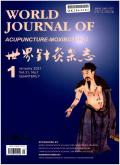The analgesic effect and ATP release at acupuncture points in response to acupuncture with different parameters on arthritis rats
IF 1.3
4区 医学
Q4 INTEGRATIVE & COMPLEMENTARY MEDICINE
引用次数: 0
Abstract
Objective
Previous studies indicated a close correlation between manual acupuncture (MA) analgesia and the mobilization of extracellular adenosine triphosphate (ATP) at the acupoints. This study attempted to investigate whether this relationship is altered with the manipulation patterns of MA. Additionally, we further testified whether these two events parallelly varied with different frequencies of electroacupuncture (EA).
Methods
Male SD rats were randomly divided into four groups: blank group, model group, MA group, and EA group. MA group was further divided into four sub-groups: standard MA, sham MA, lifting-thrusting MA, and shallow MA. Similarly, EA group was categorized based on current frequency into 2 Hz, 2–100 Hz, 100 Hz, and ARL67156+100 Hz sub-groups. For the behavioral tests, each group comprised 4–8 rats; for extracellular ATP assessment, each group consisted of 3–6 rats. Complete Freund’s adjuvant (CFA) was injected into the left ankle joint cavity to create an acute adjuvant arthritis (AA) model. A 20-minute session of either MA at left Zusanli (ST36) or EA at bilateral ST36 was administered on AA rats. Thermal hyperalgesia of the hind paw was determined. Extracellular ATP in the interstitial space at ST36 (inters. ATP) was extracted using microdialysis and quantified via a luciferase-luciferin assay.
Results
Modeling induced tenderness at ST36 (P < 0.001) and higher ATP mobilization (P < 0.05) in response to MA. Both standard MA (P < 0.001) and lifting-thrusting manipulation (P < 0.001) exhibited a remarkable analgesic effect, which was not observed with sham MA, deep insertion plus retention. Verum MA (P < 0.001) rather than sham intervention, significantly elevated inters. ATP levels. Notably, shallow MA, penetrating the skin layer and needling with twirling-rotating, demonstrated analgesia and increasing inters. ATP level (P < 0.05). Regarding EA, treatments at frequencies of 2 Hz (P < 0.01), 2–100 Hz (P < 0.05), and 100 Hz (P < 0.05) significantly alleviated pain. Only the 2–100 Hz (P < 0.05) and 100 Hz (P < 0.01) interventions, particularly in the latter, potentiated ATP mobilization. Preventing ATP hydrolysis dampened the analgesic effects of the standard MA and 100 Hz EA.
Conclusion
There is a general correlation between ATP mobilization at the acupoint and the analgesic effect of MA and EA. However, the underlying mechanisms related to shallow MA and 2 Hz EA remain to be elucidated.
不同针刺参数对关节炎大鼠镇痛作用及穴位ATP释放的影响
目的以往的研究表明,针刺镇痛与穴位细胞外三磷酸腺苷(ATP)的动员密切相关。本研究试图探讨这种关系是否会随着MA的操作模式而改变。此外,我们进一步证实了这两个事件是否随着电针(EA)的不同频率而平行变化。方法将SD大鼠随机分为空白组、模型组、MA组、EA组。MA组又分为4个亚组:标准MA组、假MA组、提推MA组、浅MA组。同样,EA组根据当前频率分为2 Hz, 2 - 100 Hz, 100 Hz和ARL67156+100 Hz子组。行为学测试,每组4-8只大鼠;细胞外ATP评价,每组3-6只大鼠。左踝关节腔内注射完全弗氏佐剂(CFA),建立急性佐剂性关节炎(AA)模型。AA大鼠分别在左足三里(ST36)处给予20分钟MA或在双侧ST36处给予EA。确定后爪热痛觉过敏。细胞外ATP在ST36 (ints)间隙。ATP)通过微透析提取,并通过荧光素-荧光素测定定量。结果ST36 (P <;0.001)和更高的ATP动员(P <;0.05)。两个标准MA (P <;0.001)和提推手法(P <;0.001)表现出显著的镇痛效果,而假MA,深度插入加保留没有观察到这一点。Verum MA (P <;0.001),而非假干预,显著升高。ATP的水平。值得注意的是,浅层MA,穿透皮肤层,旋转-旋转针刺,表现出镇痛和疼痛增加。ATP水平(P <;0.05)。对于EA,频率为2hz的处理(P <;0.01), 2-100 Hz (P <;0.05), 100 Hz (P <;0.05)显著缓解疼痛。只有2-100 Hz (P <;0.05)和100 Hz (P <;0.01)干预,特别是后者,增强了ATP的动员。结论ATP在穴位上的调动与MA和EA的镇痛效果有一定的相关性,但浅MA和2hz EA的作用机制尚不清楚。
本文章由计算机程序翻译,如有差异,请以英文原文为准。
求助全文
约1分钟内获得全文
求助全文
来源期刊

World Journal of Acupuncture-Moxibustion
INTEGRATIVE & COMPLEMENTARY MEDICINE-
CiteScore
1.30
自引率
28.60%
发文量
1089
审稿时长
50 days
期刊介绍:
The focus of the journal includes, but is not confined to, clinical research, summaries of clinical experiences, experimental research and clinical reports on needling techniques, moxibustion techniques, acupuncture analgesia and acupuncture anesthesia.
 求助内容:
求助内容: 应助结果提醒方式:
应助结果提醒方式:


